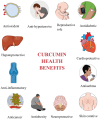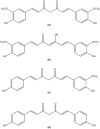On the health effects of curcumin and its derivatives
- PMID: 39620006
- PMCID: PMC11606848
- DOI: 10.1002/fsn3.4469
On the health effects of curcumin and its derivatives
Abstract
Turmeric (Curcuma longa) is an herbaceous plant that contains a phytochemical which is bright yellow and is known as curcumin. Turmeric, a member of Zingiberaceae family, has extensive application worldwide due to its beneficial medicinal attributes and is extensively used as a medicinal plant. Most people use turmeric as a spice, and it is a chief source of polyphenol curcumin. Curcuma longa has therapeutic properties, and since the initial extraction of curcumin from this plant, it has gained prodigious consideration from scientists in the medical field. The biological properties of curcumin, also known as 1,7-bis (4-hydroxy-3-methoxyphenyl)-1,6-heptadiene-3,5-dione, or diferuloylmethane, include anti-inflammatory, anti-oxidant, anti-cancer, anti-asthmatic, anti-arthritic, neuroprotective, anti-diabetic, anti-obesity, wound-healing, hepatoprotective, skin curative, reproductive role, etc. This work has reviewed many clinical trials and their findings about these activities. The focus of this review manuscript is concentrated on the presently existing clinical and animal studies, which exposed the possible anti-retroviral activities of curcumin and its by-products.
Keywords: Curcuma longa; anti‐asthmatic; anti‐inflammatory; anti‐obesity; curcumin; diferuloylmethane; pharmacological activity.
© 2024 The Author(s). Food Science & Nutrition published by Wiley Periodicals LLC.
Conflict of interest statement
The authors declare no conflict of interest.
Figures












References
-
- Aggarwal, B. B. , & Harikumar, K. B. (2009). Potential therapeutic effects of curcumin, the anti‐inflammatory agent, against neurodegenerative, cardiovascular, pulmonary, metabolic, autoimmune and neoplastic diseases. The International Journal of Biochemistry & Cell Biology, 41(1), 40–59. - PMC - PubMed
Publication types
LinkOut - more resources
Full Text Sources
Miscellaneous

